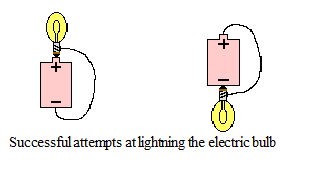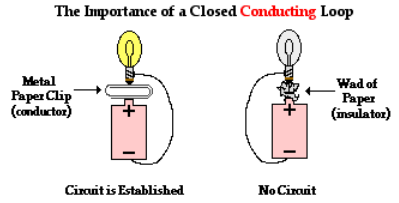- Books Name
- CBSE Class 6 Science Book
- Publication
- Param Publication
- Course
- CBSE Class 6
- Subject
- Science
Light Bulb Anatomy
A light bulb is a relatively simple device consisting of a filament resting upon or somehow attached to two wires. The wires and the filament are conducting materials that allow charge to flow through them. One wire is connected to the ribbed sides of the light bulbs. The other wire is connected to the bottom base of the light bulb. The ribbed edge and the bottom base are separated by an insulating material that prevents the direct flow of charge between the bottom base and the ribbed edge. The only pathway by which charge can make it from the ribbed edge to the bottom base or vice versa is the pathway that includes the wires and the filament. Charge can either enter the ribbed edge, make the pathway through the filament and exit out the bottom base; or it can enter the bottom base, make the pathway through the filament and exit out the ribbed edge. As such, there are two possible entry points and two corresponding exit points.
The successful means of lighting the bulb as shown above involved placing the bottom base of the bulb on the positive terminal and connecting the ribbed edge to the negative terminal using a wire. Any charge that enters the light bulb at the bottom base exits the bulb at the location where the wire makes contact with the ribbed edge. The second arrangement that lead to a lit light bulb involve placing the bulb at the negative terminal of the cell. A wire must then connect the other part of the bulb to the positive terminal of the cell.

Conductors and Insulators
(i) Conductors : Those substances through which electric charges can flow, are called conductors.
Example : silver, copper and aluminium etc.
(ii) Insulators : The material in which there is no flow of current are called insulators.
Example : Plastic, rubber and wood etc.
The Requirement of a Closed Conducting Path
There must be a closed conducting path that extends from the positive terminal to the negative terminal. It is not enough that there is simply a closed conducting loop; the loop itself must extend from the positive terminal to the negative terminal of the electrochemical cell. An electric circuit is like a water circuit at a water park. The flow of charge through wires is similar to the flow of water through the pipes and along the slides at a water park. If a pipe gets plugged or broken such that water cannot make the complete path through the circuit, then the flow of water will soon cease. In an electric circuit, all connections must be made and made by conducting materials capable of carrying charge. As the cell, bulb and wire experiment continues, some students explore the capability of various materials to carry a charge by inserting them in their circuit. Metallic materials are conductors and can be inserted into the circuit to successfully light the bulb. On the other hand, paper and plastic materials are typically insulators and their insertion within the circuit will hinder the flow of charge to such a degree that the current ceases and the bulb no longer lights. There must be a closed conducting loop from the positive to the negative terminal in order to establish a circuit and to have a current.


 PathSet Publications
PathSet Publications
 Param Publication
Param Publication
